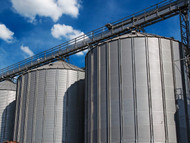Repair or Replace? Assessing Damage to Grain Bins
Published by The Grain Handling Direct Team on Jul 21st 2022
Grain bins are designed to be tall and light—while this is perfect for your purposes, it does leave the bin vulnerable to wind damage. When you have a windstorm in your area (especially one with gusts over 100 mph), you must check your containers to decide whether repairs or replacements are necessary. Keep reading to learn how to assess damage to grain bins.
Start With the Exterior
Assessing damage to your grain bin is a multistep process that begins on the ground. Start by walking around your grain bin, looking at all the walls. You want to see straight walls all the way around, along with an eave that’s parallel to the ground. You should also closely inspect the bin’s foundation—an empty bin can slide in a windstorm, so ensure the bin has stayed centered.
Get Closer
Now that you’re up close and personal, check the sealant at the foundation of your bin. If you notice that the bin is still centered on its foundation, but the sealant is damaged, you should know that the anchors or wall sheets may have failed. You can also look for corroded, missing, or broken anchor plates and bolts.
Enter the Bin
If you determine that the bin is safe, you may now enter the empty bin to inspect it from the inside. Check that the door is still square and also examine the interior walls for damage from the doorway. Check all the wind rings and stiffeners, including clips and bolts. You can also inspect the roof from below to see if roof sheets appear bent.
Don’t make repairs by yourself—hire an engineer or millwright to inspect your bins to tell you whether they can be repaired or if you should purchase new grain bins.
Now that you know how to assess damage to grain bins so you can repair or replace them, order new bins if necessary. You may want to consider investing the extra money to buy additional wind rings to improve wind resistance in the future.

